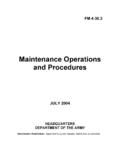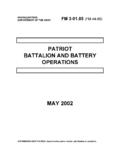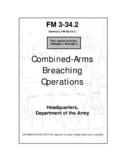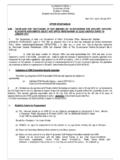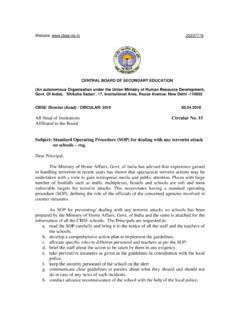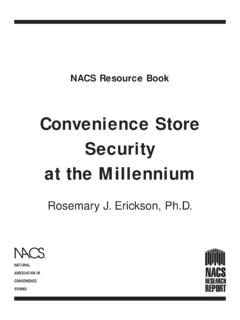Transcription of FM 90-29 NONCOMBATANT EVACUATION …
1 Jh U n. FM 90-29 NONCOMBATANT EVACUATION operations HEADQUARTERS, DEPARTMENT OF THE ARMY DISTRIBUTION RESTRICTION: Approved for publication release; distribution is unlimited. Washington, DC 20310-6050 V A * 9 FM 90-29 FIELD MANUAL HEADQUARTERS NO. 90-29 DEPARTMENT OF THE ARMY Washington,-DC, 17 October 1994 NONCOMBATANT EVACUATION operations CONTENTS Preface iv Chapter 1 Overview Description of NEO 1-1 Policy 1-2 NEO Environments 1-3 Chapter 2 US Organizations and Roles Embassy Organization 2-1 Country Team 2-2 Washington Liaison Group 2-3 Regional Liaison Groups 2-3 Other Agencies 2-3 Chapter 3 Contingency and Predeployment Planning Embassy Emergency Action Plan 3-1 Military Planning and Planning Assistance 3-3 Multinational operations 3-4 Predeployment Planning 3-5 Intelligence Preparation 3-6 Command and Control 3-6 Advance Party 3-7 Chapter 4 Deployment Intermediate Staging Base 4-1 Insertion of the EVACUATION Force 4-2 Chapter 5 EVACUATION Force operations Organization and Mission 5-1 Command and
2 Control Element 5-1 Marshalling Force 5-2 Security Force 5-3 Logistics Element 5-4 Administrative Element 5-4 Initial Actions 5-5 Route Selection 5-5 DISTRIBUTION RESTRICTION : Approved for public release; distribution is unlimited. FM 90-29 Preparation of Equipment 5-6 Marshalling Force operations 5-6 Transportation 5-7 Movement Control 5-7 Assembly Area operations 5-7 Securing Assembly Area 5-7 Dispatching Search Squads 5-8 Processing Evacuees 5-9 ECC operations 5-11 Processing Center Procedures 5-11 Reception Station 5-12 Registration Station 5-13 Debriefing Station 5-14 Medical Station 5-14 Embaikation Station 5-14 Comfort Station 5-15 operations Center Procedures 5-15 Executive Officer 5-16 operations Officer 5-16 Intelligence Officer 5-16 Logistics Officer 5-18 Personnel Officer 5-19 Pub c Affairs Officer (PAO) 5-19 Civil Affairs Officer 5-19 Signal Officer (SIGO)
3 5-20 Withdrawal of EVACUATION Force 5-20 Chapter 6 Safehaven operations Safehaven Site 6-1 Oiganization and Functions 6-1 Disposition of the Safehaven Force 6-3 Appendix A Psychological operations A-l Appendix B Guidelines for Rules of Engagement General B 1 Suggested Rules of Engagement B-2 Appendix C Sample EAP Checklists Checklist for US Military-Assisted EVACUATION C-l Assembly Area C-3 Helicopter Landing Zone C-4 Airfield Survey C-5 Seaport Survey C-7 Routes C-8 Appendix D NEO Planning Guidance Advance Party or Liaison Team Guidelines D-l Routine Information Requests D-2 il Appendix E Appendix F Appendix G Appendix H Glossary References Index Possible Dilemmas D-3 EVACUATION Contiol Center Considerations D-4 ISB Considerations D-5 Staff Guidelines D-5 Repatriation Processing Center Processing Sheet E-l Sample Pallet Configurations for NEO Deployment F-l NEO Legal Guidelines International and Domestic Law G-l Use of Deadly Force G-2 Status of Detainees G-2 Claims G-2 Sample Unified Command Public Affairs Plan NONCOMBATANT EVACUATION Operation (HN) Section I.
4 Situation, Mission, Execution, and Security H-l Section II. General Ground Rules for the Media H-4 Section III. Media Statements for Courses of Action H-5 Section IV. Joint Information Bureau (JIB) (U) H-7 Section V. Principles of Information for News Media Coverage of DOD operations (U) H-8 . Glossary-1 References-1 Index-1 FM 90-29 PREFACE Field Manual (FM) 90-29 establishes Army guidance for planning, coordinating, and executing NONCOMBATANT EVACUATION operations (NEOs) under nonemeigency conditions. Nonemergency conditions are those in which full mobilization has not been authorized, but deployment of combat forces or the use of force may be required to accomplish the missioa The manual provides direction to Army commanders and staffs charged with duties related to these operations .
5 It attempts to harmonize procedures and terminology between the various government agencies that may be involved. It does not duplicate or supplant established doctrine dealing with tactical or strategic operations but provides a specific framework to apply that doctrine. Commanders with this type of mission should ensure that their planning staff is acquainted with reference publications to reduce the potential for flawed coordination and mission execution. The proponent of this publication is the US Army Combined Arms Center and Fort Leavenworth. Send comments and recommendations on DA Form 2028 directly to Commander, US Army Combined Arms Center and Fort Leavenworth, ATTN: ATZL-SWW-L, Fort Leavenworth, Kansas 66027-6900. Unless this publication states otherwise, masculine pronouns do not refer exclusively to mea CHAPTER 1 OVERVIEW DESCRIPTION OF NEO NONCOMBATANT EVACUATION operations (NEOs) are conducted to evacuate civilian noncombatants and nonessential military personnel from locations in a foreign (host) nation during time of endangerment to a designated safehaven.
6 NEOs are normally conducted to evacuate United States (US) citizens whose lives are in danger from a hostile environment or natural disaster. NEOs may also include the EVACUATION of US military personnel and dependents, selected citizens of the host nation (HN), and third country nationals. NEOs would not normally include retrograde operations of military personnel solely as part of a military operation. NEOs involve swift, temporary occupancy of an objective and end with planned withdrawals. They may include the use of force. If so, the commander limits the amount of force to that required to protect the evacuees and the EVACUATION force. Every US embassy is required to maintain an emergency action plan (EAP), which includes a NEO plan. The Department of State is the lead agency for planning and conducting NEOs.
7 NEO plans consider HN assets as the primary source of security, transportation, and temporary facilities. If HN assets are inadequate or unavailable, US military resources are used to fill the shortfall. If military forces are employed in a NEO, they usually comprise units from more than one service. The combatant commander (commander in chief (CINQ), on being ordered to support a NEO, normally designates a joint task force (JTF) commander to exercise overall control of operations involved in the NEO. He is responsible for all activities, from initial planning and deployment to an intermediate staging base (1SB), to conduct of the EVACUATION and, if required, operation of the safehaven. EVACUATION operations differ from other military operations in that direction of the operation will usually remain with the American ambassador, if present, at the time of evacuatioa Further, the order to evacuate is usually a political decision, with extensive ramifrcations.)
8 It indicates to the local population and other governments that the situation has deteriorated to the point that the United States has lost faith in the HN s ability to maintain control of the situation. This, in turn, may further destabilize the situatioa Requesting military assistance in an EVACUATION is potentially more destabilizing. The presence of armed US troops may overly alarm the local population, adding to the possibility of unnecessary violence and confusion. Should circumstances require introduction of US troops, the commander should plan for early execution of psychological operations (PSYOP) to project and define his intentions to the HN government, military, and populace. (See Appendix A for PSYOP guidance.) Although each embassy will have an EAP, the commander should not automatically assume its data is accurate and up to date.
9 Prior coordination and site survey will probably have been restricted. The commander must be prepared to deal with the situation as it exists at the time of EVACUATION . The Department of State determines the EVACUATION sites and timing of the operation. Evacuations can be politically sensitive and are monitored, if not controlled, from the highest level. Military units aiding in the EVACUATION of US and other noncombatants whose welfare is threatened must protect themselves and their charges throughout the EVACUATION . As a situation develops, the unit secures assembly areas and an EVACUATION site, establishes defensive perimeters, and locates and escorts evacuees. Protecting the force and its charges may include establishing physical barriers to protect assembly areas and EVACUATION sites.
10 Crowd-control agents and tactics and employment of tactical PSYOP teams (TPTs) may be necessary to extract evacuees or discourage hostilities. Dissemination and enforcement of clearly defined rules of engagement (ROE) are critical. Although the objective is not to destroy enemy forces and armed conflict should be avoided whenever possible, it may become necessary. The HN government, military, and general populace must be advised of the ROE and intent of US and multinational forces. Well-publicized intentions preclude operation interference. Civil affairs (CA) and PSYOP forces are trained and equipped to develop, produce, and disseminate information that conveys the commander s mission in the language of the country of operatioa The situation will probably be such that the EVACUATION force commander may have to defend the 1-1 FM 90-29 EVACUATION from hostile forces without first informing higher authorities.
